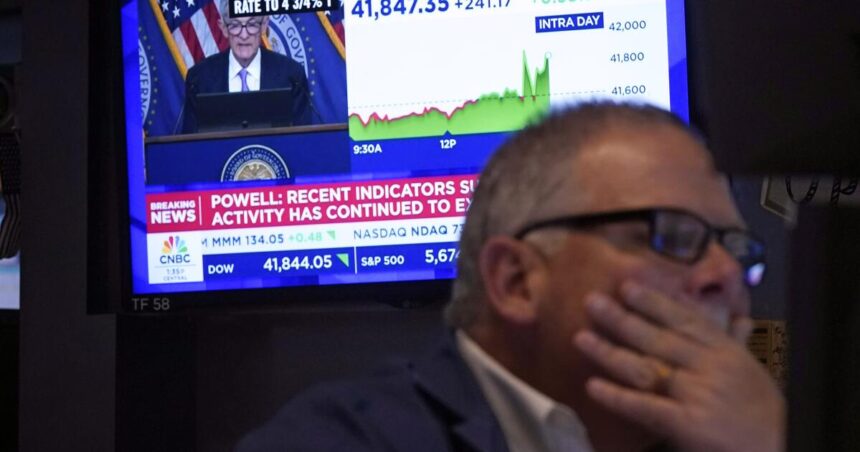U.S. stock indexes edged lower on Wednesday after the Federal Reserve began efforts to stave off a recession with a larger-than-usual cut in interest rates.
The Standard & Poor’s 500 index fell 0.3%, 0.9% below its all-time high set in July. The Dow Jones Industrial Average fell 103 points, or 0.2%, but is still near the record it set on Monday. The Nasdaq Composite fell 0.3%.
Any significant action by the Fed would help financial markets in two big ways: It would take the brakes off an economy that has been slowing under the weight of rising interest rates, and it would boost the prices of all kinds of investments. In addition to stocks, the price of gold and bonds had already risen in recent months on the expectation of a rate cut.
The move was so well communicated, and markets had already rallied significantly in anticipation of it, that Wall Street’s reaction was relatively muted despite the Fed’s historic move. It marked the first cut in the federal funds rate in more than four years, closing the door in one fell swoop to a situation in which the Fed had kept interest rates at 20-year highs in an effort to slow the economy enough to tame the worst inflation in generations.
Now, with inflation appearing to be heading toward 2 percent, having eased significantly from its peak in the summer two years ago, the Fed says it can focus more on protecting the slowing job market and the broader economy.
“The time to support the labor market is when the labor market is strong, not when you start to see layoffs,” Federal Reserve Chairman Jerome H. Powell said. “And that’s the situation we’re in.”
The only question is how much the Fed will ultimately cut rates, which could be a tricky balance. Lowering interest rates would help the economy by making it easier for American businesses and households to borrow, but it could also provide further fuel for inflation.
The Fed released its forecast on Wednesday and said officials expect to cut the federal funds rate by another half a percentage point by the end of the year, which could mean traditional-sized cuts of a quarter of a percentage point at each of its two remaining meetings scheduled for 2024.
After that, the median Fed official expects another maximum percentage point cut to occur in 2025.
Some critics say the Fed has already kept interest rates high for too long, potentially damaging the economy.
“If the Fed is behind the curve, it may need to make big moves to catch up to where it should be,” said Brian Jacobsen, chief economist at Annex Wealth Management.
“I don’t think we’re behind the curve,” Powell said at a news conference after the Fed’s announcement. “We think this is timely, but I think you’ll take this as a sign of our determination not to get behind the curve,” he said, pointing to Wednesday’s sharp half-percentage-point cut. Powell called it a “good, strong start.”
Critics say the Fed needs to be careful not to cut rates too much because inflation could remain stubbornly higher than it has been in recent decades.
Chairman Powell reiterated multiple times that the Fed is in no “rush to get this done” and that interest rates will be determined depending on upcoming data at upcoming meetings.
“We will move as fast or as slow as we see fit in real time,” he said. For now, he said, “the U.S. economy is in a good position, and our decisions today are intended to keep it that way.”
Like stock prices, Treasury yields fluctuated up and down immediately after the Fed announced its rate cut and released its forecasts.
The yield on the 10-year Treasury note finally rose to 3.70% from 3.65% late Tuesday. The yield on the two-year note, which is closer to the Fed’s expected action, rose to 3.62% from 3.60% late Tuesday.
On Wall Street, Intuitive Machines jumped 38.3% after the company signed a contract worth up to $4.82 billion for communications and navigation services that NASA will use to establish a long-term presence on the lunar surface.
Trading of the Tupperware brand remained halted after the company filed for Chapter 11 bankruptcy protection. Shares have fallen to 51 cents since a mini-revival early in the COVID-19 pandemic sent them trading above $30.
McGrath RentCorp, which rents and sells mobile office trailers, portable classrooms and other structures, fell 3.1% after it agreed to abandon a takeover bid by WillScott following increased scrutiny of the takeover plan by U.S. regulators.
Overall, the S&P 500 fell 16.32 points to 5,618.26, the Dow Jones Industrial Average lost $103.08 to 41,503.10 and the Nasdaq Composite lost $54.76 to 17,573.30.
Overseas stock markets saw indexes rise across much of Asia before falling slightly in Europe.
The Bank of Japan and the Bank of England are also meeting later this week. Neither central bank is expected to move on interest rates, but comments from officials could be an indicator of future moves and could still influence markets.
Cho is a contributing writer for The Associated Press. Associated Press writers Yuri Kageyama and Matt Ott contributed to this report.









